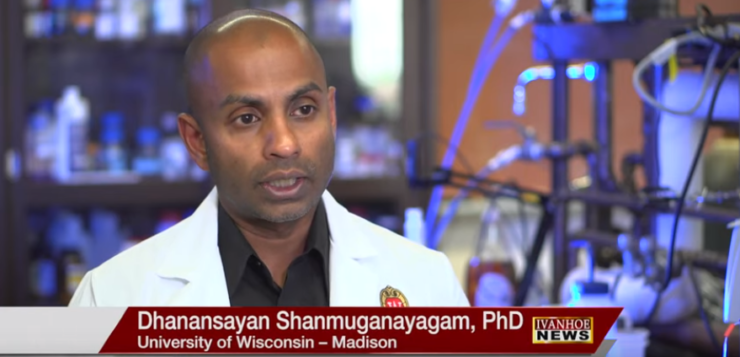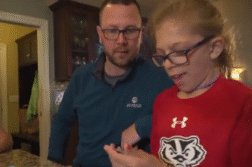Dhanansayan Shanmuganayagam, PhD, Director of Biomedical & Genomic Research Group at University of Wisconsin – Madison, talks about a research study to help kids with NF1.
Interview conducted by Ivanhoe Broadcast News in May 2019.
Could you tell me a little bit about the study that you’re doing with the NF1?
SHANMUGANAYAGAM: So NF1 is a fairly complex disease affects about one in 2,300 children. There are over 4,000 different mutations of a particular gene that causes it. There are 4,000 that have been identified. It’s complex because every child has a different version of the disease. So, the biggest hurdle in this research area has been that there was no real way to study the disease because there aren’t enough children with the same mutation. There has been a reliance on using animals as a model to study them. Unfortunately, a lot of their work with rodent models – mouse models for example, have not really panned out when they’ve been trying to develop drugs. So, we identified that the gap in the research is the appropriate model to really study the disease. Pigs being very similar to humans in many, many different ways, we decided to genetically engineer them to have the mutation that would be found in a child. Then we could study the disease in the pig. And then we could try to discover new drugs or therapies using the pig as the model.
What are the benefits of using pigs as compared to using mice?
SHANMUGANAYAGAM: They’re valuable in understanding certain mechanisms you’re trying to study. The issue with some of the smaller models, like the mouse is that it will capture one aspect of the disease but they don’t really allow you to study the disease in a very complex setting. Meaning if a person is eating a particular type of diet, how does that influence the disease. Pigs being very similar in diet, what they eat and everything to humans plus all their anatomy, their physiology and a lot of genetics as well, you can really model a lot of the complexity and all those interactions that you might not have thought about. The other aspect of it is because of the size of the pigs, you can actually use a lot of the medical equipment and instrumentation that is available already to humans in studying the disease. So, for example, you can use an MRI and CT that is used clinically in humans to study a lot of the disease process.
Going back to NF1, what are some symptoms that people experience who have the disease?
SHANMUGANAYAGAM: NF1 in people is quite different as I said from one person to another. But in general most of the children will tend to have some level of behavior or learning disabilities and cognition. And the severity will vary. The other thing that they are predisposed to is is getting tumors, nerve and brain tumors. And throughout life, they can get tumors. Some of them will be benign and some will become malignant. If they do advance to malignancy, which occurs in about ten percent of children with tumors, the prognosis is fairly poor.
What have you seen so far with your research?
SHANMUGANAYAGAM: Our pigs are really starting to understand the what you call phenotypes, which is the symptoms that they present. They were using complex types of phenotypes that have been reported in patients. So, we see also some of those more rare phenotypes that are also being reported in patients, things like cardiovascular abnormalities, issues with their G.I. Additionally we also see the major phenotypes that have been reported. We see tumors starting to form in the pigs. And we are right now starting to understand their behavior and also trying to understand whether they have any deficit in learning and things like that.
Explain a little bit about the process of how you guys actually get this set up
SHANMUGANAYAGAM: The genetic engineering for this project really works by genetically altering the embryo of a pig. We spend quite a bit of time sort of programming the molecular tools for cutting and changing the sort of the genetics in a very precise manner. Once we’ve done that, we get embryos from donor female pigs. Then we inject the embryos with these sort of molecular guides and tools. Cutting tools that will we use to program the genetics and cause a mutation where we want it to then that embryo within about four hours is implanted into a surrogate pig mother and then she gets pregnant and then she carries those piglets to term. Those piglets will now have mutations that we have sort of induced. So, they would in a way mimic a child being born with the mutation.
What is the next step for this research?
SHANMUGANAYAGAM: We have a number of therapies that we’re exploring. We’ve been funded to look at some gene therapies for trying to ameliorate the problem. We are also trying to understand aspects of the disease that haven’t been studied before, certain mechanisms that haven’t been addressed. And we’re really interested in that because that’ll give us a fundamental understanding of how these symptoms come about and how can we then prevent those symptoms or what you call phenotypes.
What are some of those that you’re focusing on?
SHANMUGANAYAGAM: Most genes are translated by our cells. And that plays a role in the function of the cell. The translation process for some genes are a little bit more complicated or complex. So, the NF1 gene that’s what the mutation causes NF1 has a very complex way and it’s being translated. And we’re trying to understand the complexity of how that happens, and how a mutation in the gene affects that sort of reading of the gene. So that’s where our focus is at the moment.
Are there other conditions that you guys are also using this research on?
SHANMUGANAYAGAM: We use pigs for multiple other areas. We have extensively used them for cardiovascular disease. And we’ve used them to develop all sorts of drugs as well as medical devices including stents. We are also looking at metabolic syndrome – diabetes in pig models. We’re looking at other sorts of cancers, liver cancer and so and so forth. And we also are using them to study wound healing as well as things like spinal cord injury and things like that.
Is that just what you’re doing research. Or in general?
SHANMUGANAYAGAM: No in our lab, yeah.
What do you believe that this research will mean for a family that has a child with NF1?
SHANMUGANAYAGAM: We’re hoping that it will allow us to find either a cure or a therapy. One of our fundamental goals is very different than what’s normally done is that we’re trying to model every child. So, we’re trying to create a pig that sort of represents a particular child. And therefore, we can really customize the treatment of the therapy. So, I think even understanding things like behavior and figuring out if they’re behavioral problems in the pigs, and if we can find ways to either treat them or to make sure that they don’t get severe, I think that means a lot to families dealing with this issue because behavior is one of those things that they deal with every day. It can become very tiresome because a lot of the NF children will have autism-like symptoms and they have a lot of learning disabilities and social problems in schools.
SHANMUGANAYAGAM: The miracles of post-production will take care of that.
How did it feel the first time we got that first pig?
SHANMUGANAYAGAM: It was quite ecstatic one when we first got our first genetically engineered pig for NF1. I think it was a very moving moment for us. I was in a meeting with actually several parents and children. We were discussing where this was going to go. And my staff sent me a live video feed of the piglet being born. It was a very emotional moment for all of us. There’s a lot of tears in the room. And that then also told us OK, let’s get moving now that we have that first model.
Anything else that you think that we should know?
SHANMUGANAYAGAM: On of the things about NF1 I’d like to get people to know is that it is not a rare disease. It’s fairly common compared to a lot of others that we have heard about. And I think awareness of this disease allows people to understand that there are kids in their schools that have these issues. And these are genetic disorders that it causes. So, we’d like more people to be aware of the disorder.
END OF INTERVIEW
This information is intended for additional research purposes only. It is not to be used as a prescription or advice from Ivanhoe Broadcast News, Inc. or any medical professional interviewed. Ivanhoe Broadcast News, Inc. assumes no responsibility for the depth or accuracy of physician statements. Procedures or medicines apply to different people and medical factors; always consult your physician on medical matters.
If you would like more information, please contact:
Dhanansayan Shanmuganayagam, PhD
Sign up for a free weekly e-mail on Medical Breakthroughs called First to Know by clicking here




